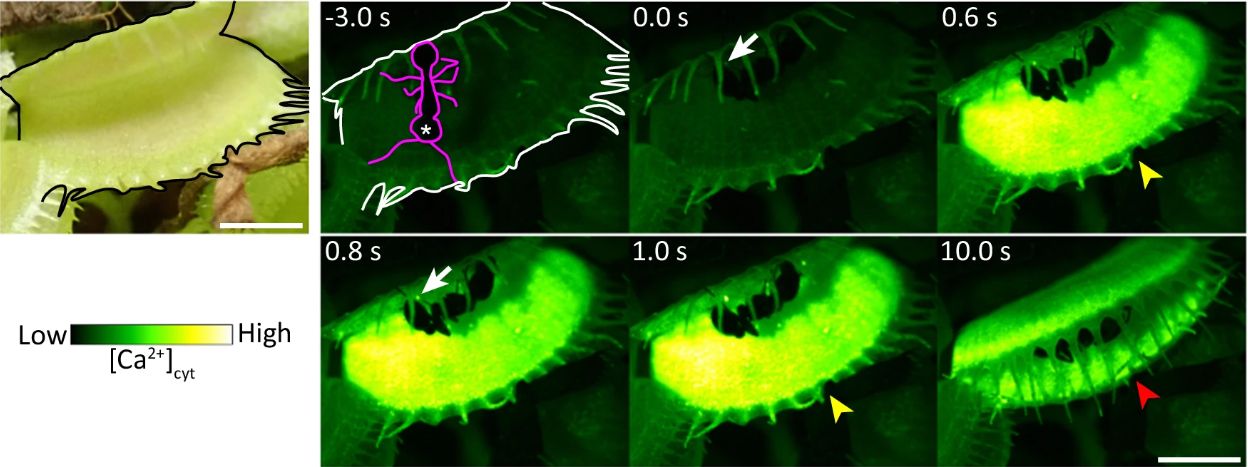Science
Researchers Unlock Secrets of Venus Flytrap’s Rapid Response

The Venus flytrap, a remarkable carnivorous plant known for its swift prey-capturing mechanism, has revealed new insights into its sensory response mechanisms. Researchers led by Hiraku Suda published findings in Nature Communications, detailing the role of a mechanosensor called DmMSL10 in the plant’s ability to react quickly to touch, a crucial adaptation for catching insects.
Understanding the Mechanism of Response
Carnivorous plants like the Venus flytrap (Dionaea muscipula) utilize specialized structures to ensnare prey. While other species, such as the waterwheel plant (Aldrovanda vesiculosa), exhibit slower movement, the rapid closure of the Venus flytrap occurs in mere seconds. Researchers sought to unravel the specific mechanisms behind this remarkable speed and precision.
Previous studies established that the sensory hairs lining the leaves of the Venus flytrap respond to specific stimuli by utilizing calcium threshold signals. However, the precise workings of this mechanism remained unclear until now. The recent research identifies DmMSL10 as a pivotal mechanosensor responsible for the plant’s heightened sensitivity.
Key Findings from the Study
The research involved creating a knockout variant of the DmMSL10 channel, which is a stretch-activated chloride ion channel. In experiments, both the wild-type and the knockout variants demonstrated a similar release of calcium ions upon mechanical stimulation. However, the rate of action potential generation was significantly lower in the knockout variant. This indicates that DmMSL10 is essential for detecting subtle movements, enabling the plant to sense and capture prey effectively.
To further demonstrate the impact of DmMSL10, the researchers conducted an experiment where ants were allowed to wander on the leaves of both the wild-type and the knockout plants. The wild-type Venus flytrap captured the first ant to land on its leaf, while the knockout variant displayed no response even after multiple ants walked across its surface. This stark contrast underscores the crucial role of the mechanosensor in prey detection.
With these findings, scientists now have a clearer understanding of the mechanisms that allow the Venus flytrap to generate long-range calcium signals essential for its survival. The study opens avenues for further research into how these intricate mechanisms evolved alongside similar functionalities in the animal kingdom.
The revelations about D. muscipula not only enhance our understanding of plant biology but also highlight the complex interactions between plants and their environments. As researchers continue to explore these mechanisms, they may uncover additional insights into the evolutionary adaptations that enable such sophisticated responses in the natural world.
-

 Lifestyle5 months ago
Lifestyle5 months agoLibraries Challenge Rising E-Book Costs Amid Growing Demand
-

 Sports4 months ago
Sports4 months agoTyreek Hill Responds to Tua Tagovailoa’s Comments on Team Dynamics
-

 Sports4 months ago
Sports4 months agoLiverpool Secures Agreement to Sign Young Striker Will Wright
-

 Lifestyle4 months ago
Lifestyle4 months agoSave Your Split Tomatoes: Expert Tips for Gardeners
-

 Lifestyle4 months ago
Lifestyle4 months agoPrincess Beatrice’s Daughter Athena Joins Siblings at London Parade
-

 Science4 months ago
Science4 months agoSan Francisco Hosts Unique Contest to Identify “Performative Males”
-

 World4 months ago
World4 months agoWinter Storms Lash New South Wales with Snow, Flood Risks
-

 Science5 months ago
Science5 months agoTrump Administration Moves to Repeal Key Climate Regulation
-

 Business5 months ago
Business5 months agoSoFi Technologies Shares Slip 2% Following Insider Stock Sale
-

 Science5 months ago
Science5 months agoNew Tool Reveals Link Between Horse Coat Condition and Parasites
-

 Sports4 months ago
Sports4 months agoElon Musk Sculpture Travels From Utah to Yosemite National Park
-

 Science5 months ago
Science5 months agoNew Study Confirms Humans Transported Stonehenge Bluestones









